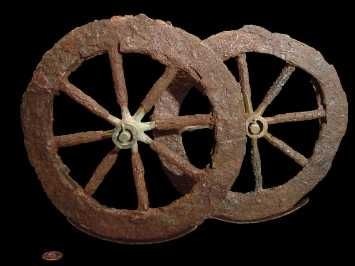Ever wondered how we got from dragging stuff around to zooming down highways? It’s all thanks to the evolution of wheels. Let’s roll through this journey together and dive deep into how these round wonders changed the world!
The Birth of the Wheel: Not Just Round Rocks
Picture this: You’re an ancient human, trying to move a massive stone block. Frustrating, right? That’s where the wheel comes in. But here’s the kicker – wheels didn’t start as perfect circles.
Early wheels were more like logs under heavy objects. Smart, but not exactly smooth sailing. It took ages for someone to think, “Hey, what if we slice these logs into discs?” And boom – the first real wheels were born.
The Mesopotamian Mystery
The oldest wheel we’ve found? It’s about 5,500 years old, discovered in Mesopotamia. But here’s the thing – we’re pretty sure the concept is way older. Some clever cookies probably figured it out earlier, but the evidence just hasn’t survived.
Why Wheels Were a Big Deal
Wheels weren’t just about moving stuff easier. They changed everything:
- Agriculture: Ploughs became way more efficient.
- Trade: We could transport goods further and faster.
- Warfare: Chariots became the tanks of the ancient world.
- Pottery: The potter’s wheel revolutionized craftsmanship.
It’s not an exaggeration to say wheels helped build civilizations. Not bad for a round piece of wood, eh?
From Wood to Metal: Durability Enters the Chat
Wooden wheels were cool, but they had a nasty habit of falling apart. Not ideal when you’re hauling your stuff across bumpy terrain. Enter metal – the game-changer in the evolution of wheels.
The Bronze Age Roll-Out
Around 2000 BCE, bronze-rimmed wheels hit the scene. Suddenly, wheels could handle more weight and rougher roads. This wasn’t just an upgrade; it was a revolution.
Iron Age Innovations
Fast forward to the Iron Age, and wheels got even tougher. Iron-rimmed wheels could carry heavier loads over longer distances. This wasn’t just about moving stuff; it was about connecting people and cultures across vast distances.
The Chariot Revolution
Metal wheels made chariots possible. These weren’t just fancy carts; they were ancient supercars. Fast, agile, and perfect for warfare. Imagine being a foot soldier and seeing a line of chariots coming at you. Terrifying, right?
Spokes: The Weight Loss Program for Wheels
Ever tried to move a solid wooden wheel? It’s like trying to roll a boulder uphill. Not fun. That’s where spokes come in – the ultimate wheel diet.
Why Spokes Rock
- Lighter wheels = faster movement
- Less material = cheaper to make
- Flexible design = absorbs shocks better
Spokes made wheels lighter without sacrificing strength. It’s like the wheel hit the gym and got ripped. This wasn’t just about looking good; it meant wheels could move faster and carry more weight. Win-win!
The Chariot Connection
Spoked wheels took chariots from “pretty fast” to “holy cow, that’s quick!” They were the Formula 1 cars of the ancient world. Egypt, China, Greece – everyone wanted in on the spoked wheel action.
Beyond War: Spokes in Everyday Life
But it wasn’t all about war. Spoked wheels made everyday transport easier too. Imagine a farmer’s cart with solid wheels versus spoked ones. The difference in effort? Massive. It’s like going from pushing a wheelbarrow to driving a tractor.
The Rubber Revolution: Comfort Enters the Scene
Imagine riding in a carriage with wooden or metal wheels. Your teeth would be chattering out of your head! That’s where rubber steps in, bringing the smooth factor to the evolution of wheels.
Rubber’s Rocky Start
The first rubber tires weren’t great. They were solid rubber – better than metal, sure, but still pretty bumpy. It wasn’t until 1887 that John Boyd Dunlop invented the pneumatic tire. That’s the air-filled tire we know and love today.
Why Pneumatic Tires Changed the Game
- Smoother rides: Less vibration means happier passengers.
- Better grip: Rubber sticks to the road way better than metal.
- Speed boost: Less resistance means you can go faster.
- Fuel efficiency: Easier rolling means less energy needed.
The Bicycle Boom
Pneumatic tires didn’t just change cars; they revolutionized bicycles. Suddenly, bikes weren’t bone-shaking torture devices. They became smooth, efficient, and fun. The bicycle boom of the late 19th century? Thank rubber tires for that.

Modern Marvels: High-Tech Wheels Roll In
Now, we’re not just talking about round things that spin anymore. Modern wheels are engineering masterpieces. We’ve got:
Airless Tires: Punctures, Be Gone!
Imagine never having a flat tire again. That’s the promise of airless tires. They use flexible spokes instead of air. Benefits?
- No more punctures
- Less maintenance
- Better for the environment (fewer tires in landfills)
Companies like Michelin are already testing these on real vehicles. The future of never changing a tire? It’s closer than you think.
Smart Wheels: Your Tire’s Got Brains
Modern wheels aren’t just dumb chunks of rubber and metal. They’re getting smart:
- Sensors that detect road conditions
- Tires that can change their shape for better traction
- Wheels that can harvest energy from rotation
It’s like your wheels went and got a computer science degree while you weren’t looking.
Carbon Fiber: Lightweight Champions
Carbon fiber wheels are the supermodels of the wheel world – impossibly light and surprisingly strong. They’re not just for show, though:
- Lighter wheels mean better fuel efficiency
- Stronger material means they can handle more stress
- They look cool as hell (admit it, that matters)
The Future of Wheels: What’s Next?
So, where’s the evolution of wheels heading? Buckle up, because it’s getting wild:
- Shape-shifting wheels: Imagine wheels that can change their shape to handle different terrains. Snow? No problem. Sand? Easy peasy.
- Self-repairing tires: Got a puncture? No worries. These tires heal themselves. It’s like giving your wheel super-fast regeneration powers.
- Energy-generating wheels: What if your wheels could power your car? Some companies are working on wheels that capture the energy of rotation and turn it into electricity.
- 3D-printed custom wheels: Need a specific wheel for a specific job? Just print it out. Custom wheels could become as easy as hitting “print” on your computer.
Sounds like sci-fi? Maybe. But so did airless tires a few decades ago. The evolution of wheels isn’t slowing down; it’s speeding up.
FAQs: Rolling Through Your Wheel Questions
Q: Who invented the wheel? A: Tough one! We don’t know exactly who, but the oldest wheel we’ve found is about 5,500 years old, discovered in Mesopotamia. It’s likely the concept is even older, but earlier evidence hasn’t survived.
Q: Why are most wheels round? A: It’s all about efficiency. Round wheels roll smoothly with less friction. Nature’s been doing round for ages – just look at how water droplets form! Round shapes distribute force evenly, making them ideal for movement.
Q: Can wheels be shapes other than circular? A: Absolutely! There are square wheels for some specialized vehicles and even wave-shaped wheels for certain applications. But for most uses, round still rules because it’s the most efficient shape for continuous rotation.
Q: What’s the biggest wheel ever made? A: The largest wheel in the world is the Singapore Flyer, a massive observation wheel standing at 165 meters tall. That’s like a 42-story building! For non-observation wheels, some of the largest are found in mining equipment, with some reaching up to 75 feet in diameter.
Q: Are wooden wheels still used today? A: Yep, but mostly for aesthetic or traditional purposes. You’ll find them on some carts, wagons, and even some bicycles for that vintage look. In some parts of the world, wooden wheels are still used in traditional agriculture.
Q: How have wheels impacted human civilization? A: Wheels have been fundamental to human progress. They’ve revolutionized transportation, enabled more efficient agriculture, facilitated trade over long distances, and even changed warfare. The wheel’s impact goes beyond transport – it’s been crucial in machinery, from water wheels to modern industrial equipment.
Q: What materials are used to make wheels today? A: Modern wheels are made from a variety of materials, including:
- Aluminum alloys (lightweight and common in cars)
- Steel (strong and used in heavy-duty applications)
- Carbon fiber (ultra-lightweight, used in high-performance vehicles)
- Rubber compounds (for tires)
- Plastics (for some small wheels or toys)
The choice of material depends on the wheel’s intended use, balancing factors like weight, strength, cost, and performance.
Wrapping Up: The Wheel Keeps Turning
From rough stone discs to high-tech marvels, the evolution of wheels has been one hell of a ride. We’ve gone from struggling to move heavy loads to cruising at high speeds in comfort. And the best part? This evolution isn’t slowing down anytime soon.
The wheel’s journey mirrors our own progress as a species. Each improvement in wheel technology has opened up new possibilities for travel, trade, and technology. It’s not just about making things roll; it’s about how rolling things have shaped our world.
Next time you’re zipping down the road, take a second to appreciate those round wonders beneath you. They’ve come a long way, baby, and they’re not done yet. The evolution of wheels is an ongoing journey, and we’re all along for the ride.
So, what’s your take on this wheely awesome journey? Got any wild ideas for the future of wheels? Maybe you’ve spotted a cool new wheel tech I didn’t mention? Drop a comment below and let’s keep this conversation rolling! After all, the next big innovation in wheel technology could be spinning around in your head right now.





